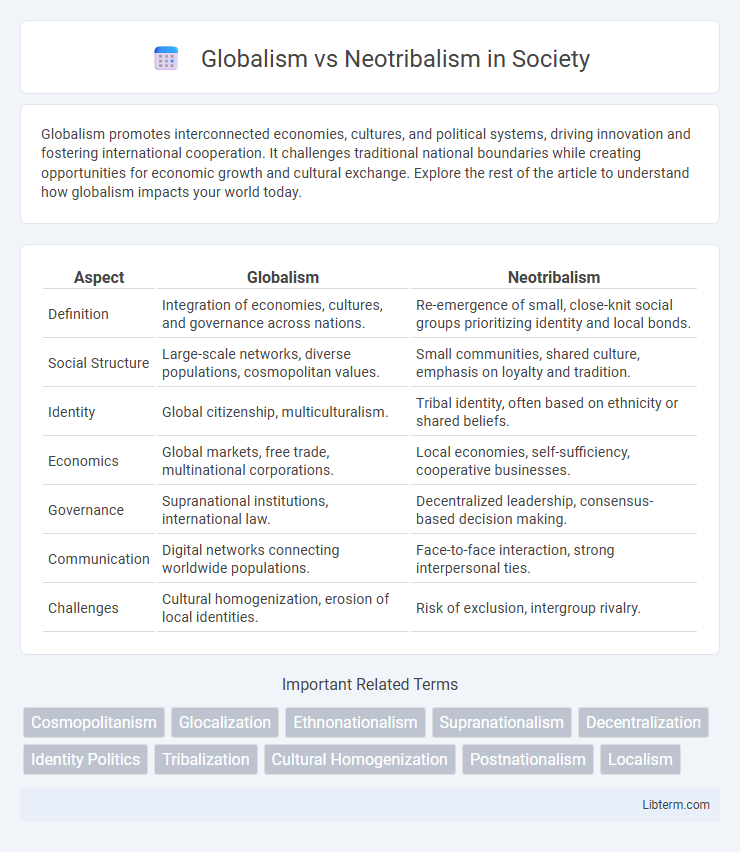Globalism promotes interconnected economies, cultures, and political systems, driving innovation and fostering international cooperation. It challenges traditional national boundaries while creating opportunities for economic growth and cultural exchange. Explore the rest of the article to understand how globalism impacts your world today.
Table of Comparison
| Aspect | Globalism | Neotribalism |
|---|---|---|
| Definition | Integration of economies, cultures, and governance across nations. | Re-emergence of small, close-knit social groups prioritizing identity and local bonds. |
| Social Structure | Large-scale networks, diverse populations, cosmopolitan values. | Small communities, shared culture, emphasis on loyalty and tradition. |
| Identity | Global citizenship, multiculturalism. | Tribal identity, often based on ethnicity or shared beliefs. |
| Economics | Global markets, free trade, multinational corporations. | Local economies, self-sufficiency, cooperative businesses. |
| Governance | Supranational institutions, international law. | Decentralized leadership, consensus-based decision making. |
| Communication | Digital networks connecting worldwide populations. | Face-to-face interaction, strong interpersonal ties. |
| Challenges | Cultural homogenization, erosion of local identities. | Risk of exclusion, intergroup rivalry. |
Understanding Globalism: Definition and Core Principles
Globalism refers to the ideology and policy framework promoting interconnectedness and interdependence of nations through economic integration, cultural exchange, and political cooperation. Core principles include free trade, open borders, multinational governance institutions, and the diffusion of technology and information worldwide. This paradigm emphasizes global solidarity, collective problem-solving, and the transcendence of national sovereignty for shared prosperity and security.
What is Neotribalism? Key Concepts Explained
Neotribalism is a sociological concept describing the resurgence of small, close-knit social groups or tribes within modern, globalized societies. It emphasizes shared identity, emotional bonds, and collective belonging, contrasting with the broad, impersonal networks encouraged by globalism. Key concepts include the desire for cultural authenticity, preference for localized decision-making, and the prioritization of group loyalty over universal ideals.
Historical Evolution: From Globalization to Neotribalism
The historical evolution from globalization to neotribalism reflects a shift from the widespread integration of economies, cultures, and political systems during the late 20th century to the resurgence of localized identities and group affiliations in the 21st century. Globalism, characterized by interconnected markets and transnational institutions such as the World Trade Organization and the United Nations, fostered economic interdependence and cultural exchange on a global scale. In contrast, neotribalism emphasizes smaller, culturally distinct communities that prioritize shared values, traditions, and social cohesion, often as a response to perceived globalization-induced cultural homogenization and loss of local identity.
Economic Impacts: Global Integration vs Local Resilience
Globalism drives economic growth through global integration, expanding markets, cross-border trade, and multinational investments, which enhance efficiency and innovation. Neotribalism emphasizes local resilience by fostering community-based economies, supporting small businesses, and prioritizing sustainable practices to reduce dependence on global supply chains. The tension between these models shapes economic policies, influencing how societies balance globalization benefits with the need for localized economic security.
Cultural Identity: Preservation or Erosion in a Globalized World
Globalism fosters interconnectedness and cultural exchange, often leading to the dilution of traditional cultural identities as global norms and values dominate local customs. Neotribalism emphasizes the revival and preservation of distinct cultural identities through a reassertion of tribal, ethnic, or community-based affiliations resisting homogenization. The tension between these forces shapes contemporary cultural landscapes, influencing how societies balance global integration with the protection of cultural heritage.
Political Structures: Supranational Governance vs Local Autonomy
Globalism emphasizes supranational governance through institutions like the United Nations and the European Union, promoting standardized policies and cross-border collaboration to address global challenges. Neotribalism advocates for local autonomy, prioritizing community-based governance and decentralized political structures that preserve cultural identities and local decision-making. The tension between these approaches shapes contemporary debates on sovereignty, governance effectiveness, and cultural preservation in an interconnected world.
Technology and Connectivity: Catalysts for Globalism and Neotribalism
Technology and connectivity have accelerated globalism by enabling instant communication, cross-border trade, and access to worldwide information networks, fostering economic integration and cultural exchange. Simultaneously, these advancements empower neotribalism by facilitating the formation of niche communities united by shared interests, identities, or values, transcending geographical boundaries. Digital platforms and social media serve as dual catalysts, supporting expansive global networks while reinforcing tribal affiliations through targeted algorithms and localized content.
Social Cohesion: Universal Values vs Tribal Belonging
Globalism promotes social cohesion through universal values such as human rights, democracy, and environmental sustainability, fostering interconnectedness across diverse populations. Neotribalism, by contrast, emphasizes social cohesion rooted in tribal belonging, shared identity, and localized traditions that reinforce group loyalty and cultural distinctiveness. The tension between globalism's broad inclusivity and neotribalism's particularistic bonds shapes contemporary debates on multiculturalism and social integration.
Challenges and Criticisms: Strengths and Weaknesses of Each Paradigm
Globalism faces challenges such as cultural homogenization and economic inequality, which often lead to diminished local identities and resistance from nationalist movements. Neotribalism, emphasizing close-knit communities and shared values, struggles with scalability and potential exclusion of outsiders, limiting broader societal cohesion. Both paradigms present strengths in fostering either interconnectedness or strong communal bonds but exhibit weaknesses in balancing inclusivity with identity preservation.
The Future Landscape: Toward Balance or Intensified Division?
The future landscape of globalism versus neotribalism hinges on whether societies achieve a balanced integration of universal values and local identities or succumb to intensified division driven by cultural and ideological fragmentation. Advances in technology and communication foster global interconnectedness, yet they also enable echo chambers and reinforce tribal allegiances. Key factors shaping this dynamic include geopolitical tensions, economic interdependence, and the resilience of cultural narratives in a rapidly evolving world.
Globalism Infographic

 libterm.com
libterm.com